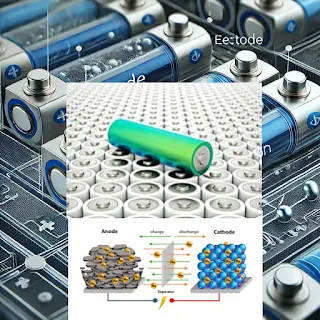Sodium-Ion Batteries: Overview and Working Principle
Sodium-ion batteries (Na-ion batteries)
are an emerging energy storage technology that operates similarly to lithium-ion batteries but uses sodium ions (Na⁺) as the charge carriers instead of lithium ions (Li⁺). Sodium is more abundant and cheaper than lithium, making Na-ion batteries a promising alternative, especially for large-scale energy storage applications.
 |
Key Components of Sodium-Ion Batteries:
1. Cathode (Positive Electrode):
Made of a sodium-containing material, such as sodium manganese oxide (NaMnO₂), sodium iron phosphate (NaFePO₄), or other layered oxides and polyanionic compounds.
2. Anode (Negative Electrode):
Commonly made of hard carbon, although other materials like sodium titanium phosphate are also being explored.
3.Electrolyte:
- Typically a sodium salt (e.g., NaPF₆, NaClO₄) dissolved in an organic solvent, facilitating the movement of sodium ions between the electrodes.
4. Separator:
- A porous membrane that separates the anode and cathode, allowing ions to pass through while preventing direct contact between the electrodes.
Working Principle of Sodium-Ion Batteries
1. Discharge Process:
When the battery discharges, sodium ions (Na⁺) move from the anode to the cathode through the electrolyte.
Electrons flow from the anode to the cathode through the external circuit, providing electrical energy to power a device.
At the cathode, sodium ions are intercalated (inserted) into the cathode material, while at the anode, electrons combine with the electrode material to maintain charge neutrality.
2. Charge Process:
- During charging, an external power source applies a voltage, causing the sodium ions to deintercalate (exit) from the cathode and move back to the anode.
- Electrons flow back to the anode through the external circuit, restoring the battery to its charged state.
- Sodium ions are stored in the anode material during this process.
Advantages of Sodium-Ion Batteries:
Cost-Effective:
Sodium is abundant and less expensive than lithium.
-Safety:
Sodium-ion batteries tend to have a lower risk of thermal runaway, which can lead to fires in lithium-ion batteries.
Environmental Impact:
Reduced reliance on scarce and geopolitically sensitive materials like lithium and cobalt.
Challenges:
Energy Density:
Na-ion batteries typically have lower energy densities than Li-ion batteries, meaning they store less energy per unit weight.
-Cycle Life:
The cycle life (number of charge-discharge cycles) may be shorter in some sodium-ion batteries compared to lithium-ion.
-Size and Weight:
Sodium is heavier than lithium, which can affect the overall size and weight of the battery.
Applications:
Grid Storage:
Due to their lower cost and safety advantages, Na-ion batteries are particularly attractive for large-scale energy storage, such as balancing supply and demand in renewable energy systems.
-Low-Cost Electronics:
Potential use in low-cost consumer electronics where high energy density is less critical.
Sodium-ion batteries are still in the developmental stage, but they hold promise as a sustainable and cost-effective alternative to lithium-ion technology, particularly for applications where cost and safety are prioritized over energy density.


.webp)


No comments:
Post a Comment